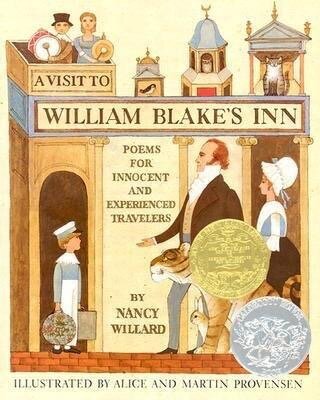Shameless Self-Promotion: William Blake's Inn
/I am forcing myself to shamelessly promote my work in a series of blog posts. It keeps me off the streets.
Today I am going to brag about what is probably my magnum opus: William Blake’s Inn, a song cycle for soloists, chorus, dancers, puppets, and everyone. NOTE: The first part of this post is telling how William Blake’s Inn came to be. If you’re interested only in what the work is, skip down to the divider.
For almost all of my career I was a school media specialist, first at the high school level and then at the elementary. My predecessor at the high school was a seriously stereotypical old lady librarian, and one of her crimes was not bothering with young adult fiction. Her philosophy — and this is a direct quote — was “The librrrarrry is for research. If the children want to read fiction, they can do that at home.” This, despite the fact that in our rural school, not that many children had fiction at home to read. The woman was an utter failure as an educator.
And so when my main bookseller offered a package deal on Newbery Award winners, I ordered it. I still remember opening that box, pulling the books out, and being slightly puzzled by one of the newest of the award winners: A Visit to William Blake’s Inn.
Surely not — a picture book? It was even a runner-up for the Caldecott Medal, the actual children’s picture book award. What the heck, Newbery committee?
Then I started reading it.
Oh my — Nancy Willard’s poetry was lovely, whimsical, deft. It was no wonder that this book was the first book of poetry to win the Newbery. (The illustrations were a perfect match.)
I immediately felt drawn to setting it to music, but after composing “When We Come Home, Blake Calls for Fire” and a couple of other pieces, I set it aside. After all, I did not have permission to create a derivative work from this copyrighted material.
Then, many years later, a group of us were invited to Ayre, our sister city in Scotland, to participate in the Scottish Opera’s The Tale o’ Tam, a work for two professional singers and as many children as you can cram onto the stage. (We were there with kids from Norway and Germany and of course Scotland; it was fantastic.)
We wanted to return the favor, to invite all our new international friends to a similar event in Newnan, but what could we stage? On the flight home I remembered William Blake’s Inn, so I pulled out my laptop and gave the existing pieces a listen. Not bad, I thought, and after we got home I offered it as an option. Everyone was enthusiastic.
Which meant that I had to approach Nancy Willard for permission to use her award-winning book. I polished up the pieces I had, burned a CD, printed out piano scores, and mailed it all off to Poughkeepsie, asking only that she not set her lawyers on me.
Nancy not only gave me permission, she resolutely refused to accept any contractual obligation to share any income from the work. Naturally, I refused right back at her, demanding that she accept a 60/40 split. She was a generous soul, something I hope I have learned from her.
That was in 2003. It took me another four years to finish the remaining pieces and then orchestrate the whole thing. (Remember that I am a complete amateur composer, plus I wrote the penguin opera for a competition in Germany.)
William Blake’s Inn has never been fully produced. We had a couple of public “readings” of the piece, and there was the 2007 “hot glue and cardboard” backer’s audition that readers of Lichtenbergianism will remember from the chapter on SUCCESSIVE APPROXIMATION. It has been offered to the Center for Puppetry Arts in Atlanta, to my alma mater UGA’s theatre department, and a small flock of professional theatres, but no one has ever staged it.
It’s easy to see why: It’s not long enough for a full evening, and too large for a children’s theatre show. There’s no script, so a producer would have to spend months in development/design if they wanted to actually stage it, as opposed to a simple choral presentation, and the costs of such a production should give anyone pause. There is a piano score if you don’t have access to an orchestra, but that doesn’t include the central “Blake Leads a Walk on the Milky Way” nor the “Epilogue,” which were the last pieces I wrote and which went straight to orchestration. Etc., etc., etc.
An image for “Sun & Moon Circus” from our development workshop in 2007 — imagine what you could do with projected imagery now!
But against all that is the simple fact that it’s a lovely work. The music is engaging, and the arc of the work is a fantastical Hero’s Journey. As one of my vocalists said at the time, “When it’s over, you’ve been somewhere.”
If you’re a theatre person, the development process we worked through in 2007 is an artistic thrill. If you’ve never been given carte blanche to develop a vision for something, this is a great opportunity. It occurs to me, too, that the advances in projected scenery since 2007 would give you amazing options. (I’m always available for consultation!)
So I offer to you William Blake’s Inn, a song cycle for soloists, chorus, puppets, dancers and everyone, consisting of fourteen songs with a prelude and an epilogue. You can find it here. You should go listen to it.
She was an amazing spirit.





